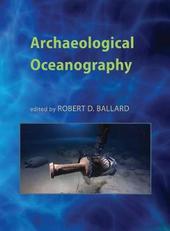
|
Archaeological Oceanography
Hardback
Main Details
| Title |
Archaeological Oceanography
|
| Authors and Contributors |
Edited by Robert D. Ballard
|
| Physical Properties |
| Format:Hardback | | Pages:296 | | Dimensions(mm): Height 254,Width 203 |
|
| ISBN/Barcode |
9780691129402
|
| Classifications | Dewey:930.102804 |
|---|
| Audience | | Professional & Vocational | | Tertiary Education (US: College) | |
|---|
| Illustrations |
170 color illus. 8 line illus.
|
|
Publishing Details |
| Publisher |
Princeton University Press
|
| Imprint |
Princeton University Press
|
| Publication Date |
21 July 2008 |
| Publication Country |
United States
|
Description
Archaeological Oceanography is the definitive book on the newly emerging field of deep-sea archaeology. Marine archaeologists have been finding and excavating underwater shipwrecks since at least the early 1950s, but until recently their explorations have been restricted to depths considered shallow by oceanographic standards. This book describes the latest advances that enable researchers to probe the secrets of the deep ocean, and the vital contributions these advances offer to archaeology and fields like maritime history and anthropology. Renowned oceanographer Robert Ballard--who stunned the world with his discovery of the Titanic deep in the North Atlantic--has gathered together the pioneers of archaeological oceanography, a cross-disciplinary group of archaeologists, oceanographers, ocean engineers, and anthropologists who have undertaken ambitious expeditions into the deep sea. In this book, they discuss the history of archaeological oceanography and the evolution and use of advanced deep-submergence technology to locate and excavate ancient and modern shipwrecks and cultural and other sites deep under water. They offer examples from their own expeditions and explain the challenges future programs face in obtaining access to the resources needed to carry out this important and exciting research. The contributors are Robert D. Ballard, Ali Can, Dwight F. Coleman, Mike J. Durbin, Ryan Eustace, Brendan Foley, Cathy Giangrande, Todd S. Gregory, Rachel L. Horlings, Jonathan Howland, Kevin McBride, James B. Newman, Dennis Piechota, Oscar Pizarro, Christopher Roman, Hanumant Singh, Cheryl Ward, and Sarah Webster.
Author Biography
Robert D. Ballard, one of the world's foremost deep-sea explorers, is perhaps best known for his discovery of the wreckage of the Titanic in 1985. He is president of the Institute for Exploration in Mystic, Connecticut, and professor of oceanography and director of the Institute for Archaeological Oceanography at the University of Rhode Island. His many books include "The Eternal Darkness: A Personal History of Deep-Sea Exploration" (Princeton).
ReviewsOne of Choice's Outstanding Academic Titles for 2009 "[W]e welcome the book as another step towards marine archaeology becoming integrated into the variety of other oceanographic sciences being used to study the marine environment."--Ingrid Ward and Piers Larcombe, Journal of Archaeological Science "This wide-ranging book will do much to inform researchers and the public about the more innovative uses of some remarkable new technologies in underwater archaeology. Many of the concepts discussed in this book can be developed further, but it is already clear that underwater archaeology is becoming established as an historical science."--Richard A. Gould, Journal of Field Archaeology "This timely and beautifully produced volume is the first to explicitly explore the examination of the residues of human activity now in the deep ocean... Famed oceanographer and Titanic wreckage discoverer Ballard also offers great case studies from many famous deep-water finds (Titanic, Bismarck, Lusitania, WW II-era shipwrecks of Guadalcanal and Midway, and JFK's PT-109), as well as less well-known ancient shipwrecks such as the Skerki Bank, Ashkelon, and Black Sea sites."--N.T. Richards, Choice "[I]t is a great synergy of the work by Ballard and his associated teams. It should enthuse students of the subject and lead them down the path to further research, and it also has a great deal to say to the casual reader who would like to be better informed about the iconic discoveries described and how them came about."--Garry Momber, Underwater Technology
|